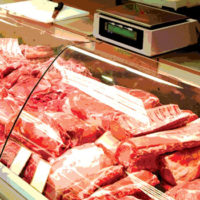Safe Food at Retail Establishments

The goal of our national food safety program is the prevention and reduction of foodborne illness. Government oversight at the national level plays an integral role in providing safe food from farm to table. This article will describe activities by the U.S. Food and Drug Administration (FDA) that are intended to improve the safety of food in retail establishments.
Over the past seven years much has been done as part of President Clinton’s Food Safety Initiative to help ensure that the United States has one of the safest food supplies in the world. For the time period 1998 to 2000, for example, there has been a 20% decrease in illnesses due to the major bacterial food pathogens across the U.S. Despite this progress, however, foodborne illnesses continue to take a staggering toll on public health and more and more frequently we read news reports about outbreaks of foodborne illness. Why?
Investigations have found a variety of causes for these outbreaks, yet many never have a food vehicle identified or determine how the food became contaminated. One of the many locales that have been associated with foodborne outbreaks is the retail establishment. Epidemiological and outbreak data have identified the following risk factors related to employee behaviors and preparation practices in retail establishments that contribute to cases of foodborne illness:
• Improper holding temperatures
• Inadequate cooking, such as with raw shell eggs
• Contaminated equipment
• Food from an unsafe source
• Poor personal hygiene
According to the Centers for Disease Control and Prevention’s (CDC) 1993-1997 Surveillance Report for Foodborne Disease Outbreaks in the US., the most commonly reported food preparation practice that contributed to foodborne disease concerned improper holding temperature; and the second concerned inadequate cooking.[1] Food obtained from an unsafe source was the least commonly reported factor. In most outbreaks caused by bacterial pathogens, the food was stored at improper holding temperatures.
A new study by Mead, et al., from the CDC estimates that in the United States, foodborne disease causes 76 million illnesses, 325,000 hospitalizations and 5,000 deaths each year.[2] Some experts feel that the risk of foodborne illness in the U.S. is increasing, with changes in the global market, an aging population, increasing numbers of immunocompromised and immunosuppressed individuals, and changes in food production practices. Since much of the reported food- borne illness is attributed to food mishandled at retail, it is essential that we have effective intervention methods in place at retail.
Faced with these facts, a food safety objective to help reduce foodborne illness has been included in Healthy People 2010, the comprehensive, nationwide set of health promotion and disease prevention objectives designed to serve as a 10- year strategy for improving health in the U.S.[3] Healthy People 2010 objectives include reducing infections caused by foodborne pathogens, reducing outbreaks of foodborne illness, and improving food employee behaviors and food preparation practices that directly relate to foodborne illnesses in retail food establishments.
THE FDA FOOD CODE: BEST ADVICE FOR FOOD SAFETY ASSURANCE
The model FDA Food Code represents FDA’s best advice for a uniform system of regulation to ensure that food at retail is safe, and properly protected and presented. It is neither federal law nor federal regulation and is not preemptive. Although not federal requirements (until adopted by federal bodies for use within federal jurisdictions), the model Food Code provisions are designed to be consistent with federal food laws and regulations and are written for ease of legal adoption at all levels of government. Providing model food codes and model code interpretations and opinions is the mechanism through which FDA, as a lead federal food control agency, promotes uniform implementation of national food regulatory policy among the several thousand federal, state and local agencies and tribes that have primary responsibility for the regulation or oversight of retail level food operations.
The Food Code was first published in its current format by the FDA in 1993. It is updated every two years to coincide with the biennial meeting of the Conference for Food Protection, a group I of representatives from regulatory agencies at all levels of government, the food industry, academia and consumer organizations that works to improve food safety at the retail level. The FDA Food Code can be found here.
The FDA, the U.S. Department of Agriculture’s (USDA) Food Safety and Inspection Service (FSIS), and CDC endorse the Food Code because it provides public health and regulatory agencies with practical science-based advice and manageable, enforceable provisions for mitigating risk factors known to contribute to foodborne disease. It is recommended that the state, local and tribal jurisdictions that have responsibility for regulating retail establishments that sell or serve food should use the Food Code as a model to help develop or update their own food safety rules and provide consistency among jurisdictions.
We are pleased to announce that in addition to the many federal agencies and tribal governments that have adopted the Code, as of May 2001, 30 states and one U.S. territory have at least one agency that has adopted one of the four editions of the Food Code published since 1993. In addition, 15 more states and one territory are in the process of adoption.
FOOD CODE INTERVENTIONS
What do we do to help control the risk factors in retail food establishments? To help control the risk factors, the Food Code provides five key public health interventions:
• Demonstration of food safety knowledge by the manager
• Management of sick workers (employee health)
• Prevention of hand contact with foods as a vehicle of contamination
• Usage of time-temperature controls
• Advising consumers about the increased risk associated with eating raw or undercooked animal foods to especially vulnerable consumers.
There are a number of challenges to ensure safe food at retail. These include a large employee population with high rates of turnover, language barriers and non-uniform systems for training and certifying workers. Retail food employees’ use of safe food preparation and storage practices such as those spelled out in the Food Code should reduce outbreaks.
 But how do we get from knowing about risk factors and using interventions to decreasing foodborne illness? Crucial to combating foodborne disease is the proper application and implementation of these interventions (Table 1). Table 1 shows that two of the interventions— hands as a vehicle of contamination and time-temperature relationships—interrelate with three of the risk factors—poor personal hygiene, inadequate cooking and improper holding temperatures. Control of a risk factor through use of a correlating public health intervention is the pathway by which we can begin to combat foodborne disease. For example, to successfully control the risks associated with inadequate cooking and improper holding temperatures, the intervention to properly monitor time-temperature relationships must be instituted.
But how do we get from knowing about risk factors and using interventions to decreasing foodborne illness? Crucial to combating foodborne disease is the proper application and implementation of these interventions (Table 1). Table 1 shows that two of the interventions— hands as a vehicle of contamination and time-temperature relationships—interrelate with three of the risk factors—poor personal hygiene, inadequate cooking and improper holding temperatures. Control of a risk factor through use of a correlating public health intervention is the pathway by which we can begin to combat foodborne disease. For example, to successfully control the risks associated with inadequate cooking and improper holding temperatures, the intervention to properly monitor time-temperature relationships must be instituted.
To successfully control the risks associated with personal hygiene, the Food Code prohibits the direct contact of ready-to-eat (RTE) foods with bare hands. Improper hand washing is a major cause of pathogen transfer from food employees to food. By prohibiting bare hand contact, we reduce the possibility of contamination from ill food employees or from cross-contamination. There are a number of ways for retail food employees to comply with this Food Code provision. Food may be contacted using a number of utensils including tongs, deli tissues or single-use disposable gloves. While gloves are not required, many retail establishments choose them for their ease of use and convenience. One glove choice is natural rubber latex. Disposable latex gloves, however, have been reported to be associated with allergic reactions when latex-allergic people eat food that has been handled with these gloves. Latex allergens in food are increasingly recognized as a potential problem and research is continuing.
For change to occur, industry and regulators must know what they are faced with; in other words, at what level the behaviors and practices occur. There is also a need for a measurable indicator that accurately measures the changes in these behaviors and practices.
YEAR 2001 AND BEYOND
We know that changes in the frequency at which the risk factors occur in retail- level food establishments can be measured, with the trends observed over time. To answer the need for a tool to measure the occurrence of the risk factors in retail food establishments, FDA developed in 1999-2000 the FDA Retail Food Database of Foodborne Illness Risk Factors, which is referred to as the FDA Risk Factor Database in this article.[4]
An initial outcome for the FDA Risk Factor Database project is to obtain a baseline number of the percent compliance with safe practices and behaviors. For example, the proportion of safe food practices that show proper holding temperatures, adequate cooking, good personal hygiene, clean equipment and foods from safe sources.
It is anticipated that a reduction in the occurrence of risk factors will have a direct impact on the number of food- borne illnesses that occur. But, because there are also other important risk factors that are independent of retail practices, it is not possible to draw a statistical correlation to a reduction in actual illnesses. The data obtained from this project will set the basis for comparison with follow- up studies conducted in the future.
PATHWAYS TO BRIDGE THE GAP
How will the use of the risk factor data prevent or reduce foodborne illness in this country by 2010? FDA has several interrelated, existing pathways to reduce or prevent foodborne illness. The risk factors and Food Code interventions link each of these “paths.”
First, the FDA Risk Factor Database is the source of the data and is used to establish a baseline on the level of occurrence of the risky practices and behaviors that we know directly relate to foodborne illness transmission. Nine facility types, grouped into three industry segments were covered during the initial 1998-1999 data collection period:
• Institutions: Grouped into hospitals, nursing homes and elementary schools
• Retail Grocery Stores: Grouped into deli department, meat and poultry department, produce department and seafood department
• Restaurants: Grouped into fast food restaurants and full service restaurants
Second is the use of FDA’S Standardization and Certification Procedures, a document that is used during the process of standardization and certification of retail food inspection personnel. It provides a uniform system of measurement that is based on the Food Code, reflects current Food Code provisions, and has a focus on the risk factors, Food Code interventions and application of the principles of Hazard Analysis & Critical Control Points (HACCP). This procedure measures a candidate’s knowledge and expertise in the application and interpretation of the interventions, the risk factors, HACCP principles, the use of essential inspection equipment and the necessary communication skills in conducting retail food establishment inspection.
RECOMMENDED NATIONAL RETAIL FOOD REGULATORY PROGRAM STANDARDS
The FDA’s Program Standards serve as a guide to regulatory retail food program managers in the design and management of a retail food program and provide a means of recognition for those programs that meet these standards. These standards establish a basic foundation in design and management of a retail food program. The Program Standards are anticipated to become the keystone in achieving national uniformity for how a food regulatory program conducts business and will serve as the foundation for all regulatory food programs. The nine standards include: Regulatory Foundation, Trained Regulatory Staff, Inspection Program Based on HACCP Principles, Uniform Inspection Program, Foodborne Illness Investigation and Response, Compliance & Enforcement, Industry and Community Relations, Program Support, and Resources and Program Assessment.
The FDA Risk Factor Database is instrumental as a model tool for use in Standard 9, Program Assessment. It is the intent, through the Program Standards, that the database is a model that each state/jurisdiction can use to develop its own program database. Each state/jurisdiction would perform their own baseline project using, as its measuring rod, the risk factors and the regulatory food safety requirements in use within their particular state/jurisdiction.
PROBLEMS ASSOCIATED WITH SICK FOOD WORKERS
The exclusion and/or restriction of ill food workers as an intervention is not working in the retail food industry, with approximately 93% of the foodborne illnesses resulting from ill food workers in the work place as reported in an FDA White Paper.[5] These data highlight a problem in the retail food industry in removing ill food workers from either the food establishment itself or, at the very least, from the tasks of food preparation. The problem is exacerbated by an increasing global marketplace, decreasing work force and the economic need for food workers to work even when ill.[6-8] More must be offered by the retail food industry beyond education to minimize this problem.
The potential for transmission of foodborne pathogens by asymptomatic food employees also limits the effectiveness of a policy that has removal of ill or symptomatic employees as the major intervention and ignores the role that handwashing plays. For example, the hepatitis A virus has an incubation period of 15 to 50 days, with up to l0 viral particles per gram of feces shed in infected individual’s feces one to two weeks before the onset of symptoms. The food worker is shedding the largest amount of hepatitis A virus in the stool, before the food worker becomes ill.
In order to control the contamination of ready-to-eat food by ill food workers, the following interventions are suggested to be used in conjunction:
• Exclusion/restriction of ill workers
• Handwashing, as specified in the FDA Food Code
• Prohibition of bare-hand contact with ready-to-eat foods, unless acceptable alternatives are approved
SUMMARY
To control the occurrence of outbreaks, as well as sporadic cases of foodborne illness at retail level establishments, managerial control of the five food safety risk factors is crucial. Adoption of the Food Code by regulatory jurisdictions establishes a sound regulatory foundation upon which the Program Standards help in the design and management of an effective food program. Add to this the use of the FDA Standardization and Certification Procedures and the anticipated results are a reduction in the occurrence of risky practices and behaviors, and ultimately, a reduction in foodborne illness.
Primary to Healthy People 2010 is the tracking of food preparation practices and employee behaviors related to the risk factors. To effectuate change, industry and government must know the level at which these risky practices and behaviors occur. Protection of the public’s health against foodborne illness for the next 10 years begins with the use of measurement indicators, such as the FDA Retail Food Database of Foodborne illness Risk Factors for baseline development. For the future, it continues with the tracking of trends, whether they are increases or decreases in the occurrence of risky food preparation practices and behaviors.
Glenda Lewis is a consumer safety officer in FDA’S Center for Food Safety and Applied Nutrition’s Office of Field Programs, Division of Cooperative Programs. She works as a member of the Retail Food and Interstate Travel Team, which has responsibility to: 1) assist jurisdictions in their direct regulation of retail, e.g. restaurants, grocery stores, health care facilities, schools, child and adult day care, penal institutions and mobile food carts; 2) to directly regulate interstate travel conveyances and support facilities; and 3) to provide assistance to jurisdictions, industry and consumers through provision of model codes, guidance documents, program standards and assessment, training, standardization and certification, regional food protection seminars, technical assistance and national conferences.
Peter A. Salsbury is a science policy analyst in FDA’S Center for Food Safety and Applied Nutrition’s Executive Operations Staff. He is responsible for food safety policy issues that include initiatives with FDA’S Office of Regulatory Affairs (field operations) and activities with other federal, state and local government agencies such as the National Food Safety System project. He has worked for FDA for 14 years.
REFERENCES
1. U.S. CDC. Surveillance for Foodborne Disease Outbreaks—United States, 1993-1997. Morbidity Mortality Weekly Report, 49(SSO1), pp. 1-51. 2000.
2. Mead, RS., et al. Food-related illness and death in the United States. Emerg. Infect. Dis. 5(5), pp. 607-625. 1999.
3. Department of Health and Human Services. Healthy People 2010. (www.health.gov/healthypeople/Publications).
4. U.S. FDA. Report of the FDA Retail Food Program Database of Foodborne Illness Risk Factors. (http://vm.cfsan.fda.gov/~dms/retrsk.html). 2000.
5. Ross, M. and J. Guzewich. Evaluation of risks related to microbiological contamination of ready-to-eat food by food preparation workers and the effectiveness of interventions to minimize those risks. FDA White Paper. CFSAN. (http://vm.cfsan.fda.gov/~ear/rterisk.html). 1999.
6. Grover, S. National Restaurant Association. Personal communication. 2000.
7. Hilgren, J. 1998. Sharing our food with strangers. Infect. Control Today pp. 12-20. May 1998.
8. Kaferstein, F.K., Y. Motarjemi and D.W. Bettcher. Foodborne disease control: A transnational challenge. Emerg. Infect. Dis., 3(4), pp. 503-511. 1997.
>
Looking for a reprint of this article?
From high-res PDFs to custom plaques, order your copy today!





